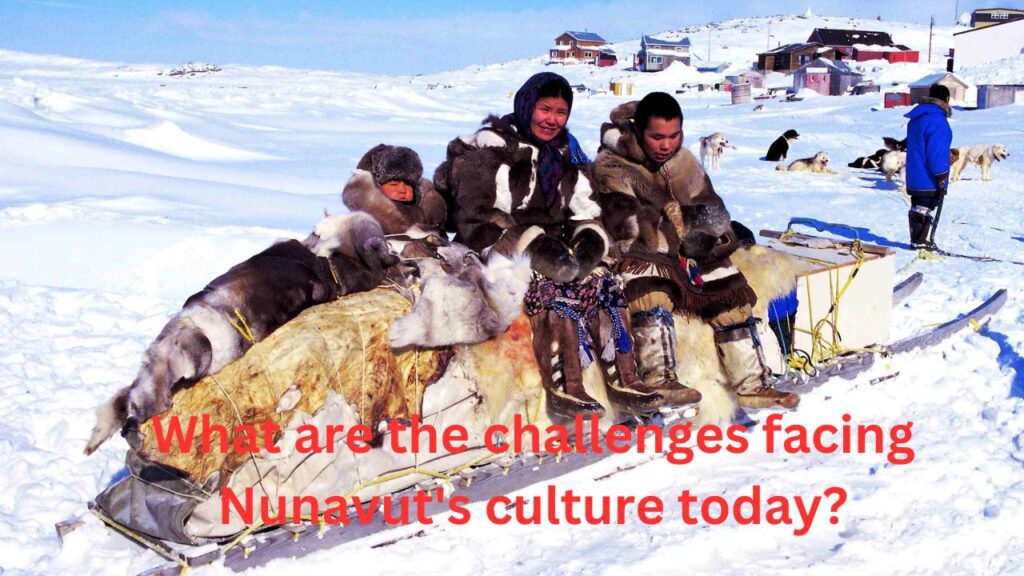Nunavut, established in 1999 as Canada’s newest territory, is home to a predominantly Inuit population that holds a rich and distinctive culture. However, like many Indigenous communities worldwide, Nunavut faces a variety of challenges that threaten the preservation of its traditional way of life and cultural practices. These challenges stem from both internal and external forces, including the impacts of modernization, climate change, economic pressures, and social issues. Despite these obstacles, the Inuit people of Nunavut remain resilient and continue to find ways to adapt and preserve their culture.
1. Climate Change and Environmental Challenges
One of the most pressing issues facing Nunavut’s culture today is the impact of climate change. The Arctic is warming at a rate more than twice the global average, which affects the region’s ecosystems, weather patterns, and way of life. Inuit communities have long relied on the land, sea, and animals for sustenance, and changes to the environment threaten this relationship. Melting sea ice, for example, disrupts traditional hunting practices, as it makes travel by snowmobile and sled more dangerous or impossible. The uncertainty in hunting and fishing patterns also impacts food security in communities where access to store-bought food is limited and expensive.
As the environment shifts, Inuit knowledge of the land—Inuit Qaujimajatuqangit (IQ)—is being put to the test. While Inuit have long adapted to their environment, the unprecedented pace of climate change requires new strategies and knowledge integration. The alteration of animal migration patterns and the uncertainty of ice conditions are forcing the Inuit to adapt quickly, which can be both a cultural and practical challenge.
2. Language Loss and Cultural Erosion
Language is a cornerstone of Inuit identity, but Inuktitut, the predominant language spoken in Nunavut, is facing a significant decline. The younger generation is increasingly shifting towards English, especially in urban areas where access to modern media, education, and technology predominates. Language loss is a serious concern because it is not only a means of communication but also carries essential cultural knowledge, traditions, and worldviews. As Inuktitut declines, so does the transmission of traditional knowledge, which is often passed down orally.
Efforts to revitalize Inuktitut are underway, with bilingual education programs and language immersion initiatives in schools. However, many challenges remain, including a shortage of qualified teachers fluent in Inuktitut and the difficulties of teaching a language in a digital age where English dominates most global communications. Without strong language preservation, the connection to the land, the traditional way of life, and Inuit values is at risk of becoming fragmented.
3. Social and Economic Inequality
Nunavut faces significant social and economic challenges, including high levels of poverty, unemployment, and limited access to healthcare and education. The high cost of living in the North exacerbates these issues, as most goods must be imported, making basic necessities such as food, clothing, and housing expensive. Inuit communities struggle with poor infrastructure, and many residents live in overcrowded conditions with limited access to essential services.
These economic difficulties often contribute to social issues such as mental health challenges, substance abuse, and high rates of suicide, particularly among youth. The disconnection between young people and traditional Inuit lifestyles, combined with a lack of employment opportunities, exacerbates feelings of isolation and cultural disintegration. As younger generations face pressure to assimilate into modern society, they may feel disconnected from their heritage, leading to a loss of cultural pride and identity.
4. Education and Cultural Disconnect
While education is essential to the development of Nunavut’s youth, the schooling system in the territory has been criticized for not adequately integrating Inuit culture and traditional knowledge. Despite efforts to incorporate elements of Inuit history, language, and values, many students in Nunavut face a curriculum that is largely based on Western models of education. This can create a cultural disconnect, as students learn in environments that often fail to reflect their lived experiences or acknowledge the full value of their heritage.
Furthermore, the high dropout rate and struggles with academic achievement in some areas reflect the challenges young people face in a system that doesn’t always align with their cultural backgrounds. A more inclusive approach, one that blends traditional knowledge with formal education, could help bridge this gap and enable students to better understand and appreciate their culture while preparing them for the future.
5. Cultural Revitalization Amid Globalization
Inuit culture is facing pressures from globalization, as Western values, technologies, and lifestyles become more prevalent. Media, social networks, and digital platforms have brought global influences to even the most remote communities. While this connectivity offers new opportunities, such as access to global markets and information, it also poses a challenge to the preservation of Inuit traditions and practices.
The rise of technology, especially among younger generations, has altered the way Inuit culture is practiced and shared. While modern platforms like social media allow for the sharing of Inuit art, language, and stories, they also contribute to the erosion of traditional ways of life, as younger people may prioritize virtual engagement over spending time on the land or engaging in community activities. There is a growing concern that traditional knowledge and practices may be overshadowed by the pull of globalized consumerism and Western cultural norms.
6. Political and Governance Challenges
Nunavut, as a relatively new territory, is still navigating its political and governance structures. While the creation of Nunavut was a landmark achievement for the Inuit people, there are still ongoing struggles with self-governance and sovereignty. The government of Nunavut faces financial constraints and is still grappling with the best ways to balance traditional Inuit decision-making practices with Western systems of governance. This can create tensions between maintaining Inuit cultural practices in governance and responding to the practicalities of modern administration.
Conclusion
Nunavut’s culture faces a range of challenges today, from environmental changes and language loss to economic disparities and the effects of globalization. While these challenges are significant, the resilience of the Inuit people and their ongoing efforts to preserve and adapt their culture offer hope for the future. Through education, community engagement, and cultural revitalization initiatives, Inuit communities in Nunavut continue to navigate these challenges, working to ensure that their traditions, knowledge, and way of life remain vibrant for future generations.



